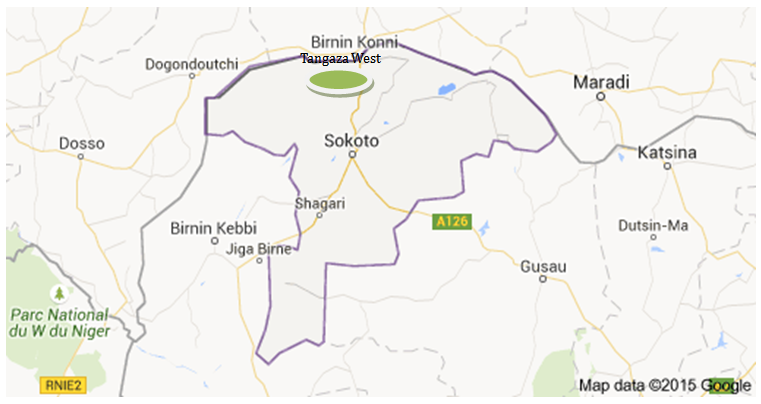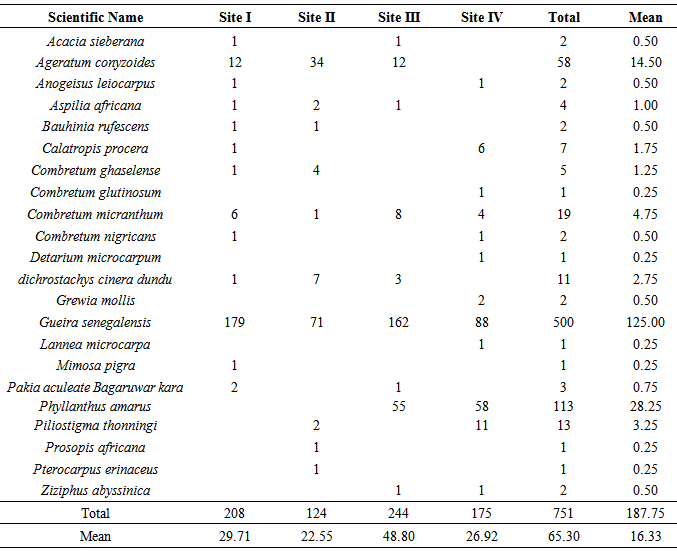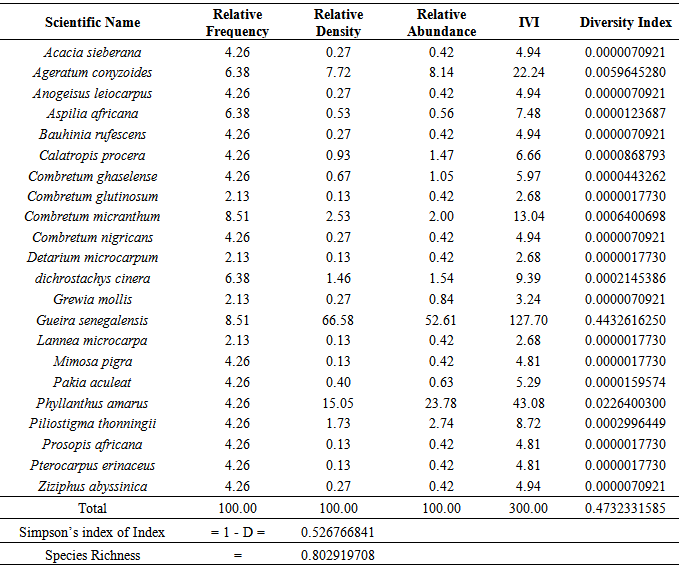-
Paper Information
- Paper Submission
-
Journal Information
- About This Journal
- Editorial Board
- Current Issue
- Archive
- Author Guidelines
- Contact Us
International Journal of Plant Research
p-ISSN: 2163-2596 e-ISSN: 2163-260X
2015; 5(4): 73-79
doi:10.5923/j.plant.20150504.01
Diversity and Phytogeographic Investigation into Woody Plants of West Tangaza Forest Reserve, Sokoto State, Nigeria
Daniel A. Zhigila1, Fatima B. J. Sawa2, Suleiman D. Abdul2, Halima M. Abba3, Murna Tela1
1Botany Programme, Department of Biological Sciences, Gombe State University, Gombe, Nigeria
2Biological Sciences Programmes, Abubakar Tafawa Balewa University, Bauchi, Nigeria
3Biology Unit, S.B.R.S., Gombe State University, Gombe, Nigeria
Correspondence to: Daniel A. Zhigila, Botany Programme, Department of Biological Sciences, Gombe State University, Gombe, Nigeria.
| Email: |  |
Copyright © 2015 Scientific & Academic Publishing. All Rights Reserved.
The diversity and phytogeography of woody plant species in the West Tangaza Forest Reserve, Sokoto, Nigeria was studied. Taxonomic/floristic and geographical diversity were integrated to put the forest in focus for the local and global conservation efforts that it deserves. Stratified random sampling using point centred quarter (PCQ) method was employed. A total of 22 species of trees and shrubs belonging to 19 genera and 12 families were identified. The family Combretaceae had the highest number of species (6); followed by the family Fabaceae (5), families Anacadaceae, Asteraceae, Asclepediaceae, Euphorbiaceae, Rhamnaceae, Tiliaceae and Lamiaceae were represented by one species each. The Importance Value Indices revealed that the forest was dominated by Guiera senegalensis (127.70) –Phyllanthus amarus (43.08)–ASpilia africa(22.24) complex. The lowest importance value indices were observed forCombretum glutinosum, Detarium micranthum and Lannea microcarpa with 2.68 each. These species showed the urgent need for conservation efforts. The Simpson’s index of diversity was 0.5268 and the species richness was 0.8029. The values were high indicating a more complex and healthier community because a greater variety of species allows for more species interactions, hence greater system stability, and indicates good environmental conditions.
Keywords: West Tangaza, Forest, Taxonomy, Diversity, Conservation, Shrubs, Trees
Cite this paper: Daniel A. Zhigila, Fatima B. J. Sawa, Suleiman D. Abdul, Halima M. Abba, Murna Tela, Diversity and Phytogeographic Investigation into Woody Plants of West Tangaza Forest Reserve, Sokoto State, Nigeria, International Journal of Plant Research, Vol. 5 No. 4, 2015, pp. 73-79. doi: 10.5923/j.plant.20150504.01.
Article Outline
1. Introduction
- Living things are interdependent, intricately linked in birth, death and renewal. Human beings are just one small part of the vibrant component of the biological systems on the earth but human beings are the vital and key biological system and put tremendous amount of pressure on species and the environment and ecosystem. As a result, many plants and animals are at risks as well as natural processes such as pollination by insects and the regeneration of soils by microorganisms and also the survival of microorganisms. Woody plants are such vital components of the ecosystem that have productive, protective and recreational functions (Atiku et al., 2013). They control soil erosion, stabilize regional and global climates; provide carbon sinks, and acts in pollution control (Adamu, 2006). The extent to which forest trees are being exploited calls for urgent attention (Zaki, 2004). The world forests are diminishing rapidly and each year about 294,020 square kilo meters of forest disappear (Fries and Herman, 1990).Taxonomic diversity mostly interpreted as the variation among and within species which includes the variation of taxonomic unities such as Phyla, Orders, Families, Genera and Species (Moksia et al., 2012). Ecosystem diversity or even better biogeographic diversity concerns with the variation in biogeographic regions, landscapes and habitats. The problems facing at present is the over exploitation of bio-resources/natural resources which would not only have negative impact on the environment but also sometimes totally destroy and erode the important bio-resources which are available at local level, regional level and national levels. Therefore, ecosystem management in a particular location is important and integral part for the conservation and protection of biological diversity of Nigeria (Bello, 2005).By understanding the status of the natural forest in terms of tree species composition, richness and diversity, recommendations can be made for the restoration and future management of the reserve. The study was a step in that direction. Specifically, the objectives of the study were: (1) to capture the composition, diversity and richness or otherwise rarity of tree species in West Tangaza Forest Reserve (2) to compare the tree species composition, diversity and richness between climax vegetation within the same environment and (3) Taxonomic/floristic and biogeographical studies are integrated to investigate the biodiversity in West Tangaza Forest Reserve and to put the region in focus for the local and global conservation efforts that it deserves.
2. Materials and Methods
2.1. The Study Area
- Tangaza Local Gov’t Area, Sokoto state (Nigeria) is locate at latitude N13.56 to 13.57 and E4.42 to 4.46° (Figure 1) while West Tangaza Forest Reserve is located at Latitude 13° 25' 00" N and Longitude 4° 30' 00" E (NGIA, 2012). Some of the villages surrounding the reserve include Yartagimba, Mulawa: Tungarnoma, Tungarfilani, Daiji, Marakenbori, Wassanniya and Jimajimi 1 and Jimajimi 2 (Atiku et al., 2013). Most of the inhabitants are Peasant farmers, Cattle rearers and Local wood carvers all of whom are dependent on forest resources for raw materials. Gazetted by colonial order number 38 in December 1937, the reserve covers an area of 174 square miles (Abegunde et al., 2001).
 | Figure 1. Map of Nigeria Showing the location of West Tangaza Forest Reserve (Map Data, 2015) |
2.2. Vegetation Cover Sampling Procedures
- The materials used for the field work include secateur polythene bags, large jute bags, pen, labelling tapes, specimen bottles, hand lens, improvised hook and measuring/calibrated tapes. Sampling for diversity and abundance was carried out randomly in every community. The point centered quarter method procedure of vegetation estimation was used in data collection as described by Mueller and Ellenberg (1974). The plant species includes all the saplings, shrubs and trees present in the study areas.
2.3. Plant Collection and Identification
- Species were identified on site with the help of taxonomic keys, field guides and floras and texts containing coloured photographs (Von Maydell, 1990; Akobundu and Agyakwa, 1998; Blench and Dendo, 2007 and Odugbemi, 2008). The unidentified plant samples collected from the study areas were flattened-out on flimsies and pressed between the absorbents under heavy pressure immediately after collection on the field; these were packaged with ventilators in the plant press for drying in the oven. The dried plants were separated and properly identified with appropriate labels for easy reference with herbarium specimens of the Gombe State University and Biological Sciences Programme Tafawa Balewa University, Bauchi., Nigeria. Unidentified specimens were deposited at the herbarium of Gombe State University. Nomenclature of the species follows Hutchinson and Dalzeil (1972). The list of identified plants was presented in Table 1.
|
2.4. Species-Effort Curve
- The thoroughness of the survey, in terms of the proportion of plant species surveyed, was estimated using a species-effort curve (Figure 2). The species effort curve shows the cumulative number of plant species per section of the four different sites. The curve shows that new species were added more quickly at the beginning of sections as it lengthened. The curve reached a clear plateau at some point and continued on an upward trend where it levels up. It became less likely that more species would be found; indicating that enough total area had been sampled to give a reliable picture of variation in plant species richness and diversity in West Tangaza Forest Reserve.
 | Figure 2. Overall species accumulation during survey effort at West Tangaza Forest Reserve |
3. Data Analyses
- Data obtained were quantitatively analyzed for Relative density, Relative frequency, relative abundance and Importance value index and calculated as follows (Curtis and McIntosh, 1951).Density is calculated by the equation:
 Importance Value Index = Relative Frequency + Relative Density + Relative Abundance Species diversity index was calculated using Simpson’s index as follows:
Importance Value Index = Relative Frequency + Relative Density + Relative Abundance Species diversity index was calculated using Simpson’s index as follows: Where:D = diversity index N = Total number of organisms of all species found n = number of individuals of a particular species The value of D ranges between 0 and 1.With this index, 0 represents infinite diversity and 1 no diversity.
Where:D = diversity index N = Total number of organisms of all species found n = number of individuals of a particular species The value of D ranges between 0 and 1.With this index, 0 represents infinite diversity and 1 no diversity. Where D = the Menhinick's index; S = the number of different species represented in the sample and N = the total number of species in the sample.The important quantitative analysis such as density, frequency, and abundance of tree species, shrubs and herbs species were determined as per Curtis and McIntosh (1951).
Where D = the Menhinick's index; S = the number of different species represented in the sample and N = the total number of species in the sample.The important quantitative analysis such as density, frequency, and abundance of tree species, shrubs and herbs species were determined as per Curtis and McIntosh (1951).4. Results and Discussion
- A total of 22 species of trees and shrubs belonging to 19 genera and 12 families were identified in West Tangaza Forest Reserve (Table 1). Plant species such as Gueira senegalensis (shrub), Combretum spp (shrubs), Piliostigma thonningii (shrub), Acacia senegalensis (shrub), Zizziphus mauritiana (shrub), Aspilia Africana (shrub) and Calatropis procera (shrub) were identified to be most common. The family Combretaceae had the highest number of species (6). This was followed by the family Fabaceae with five species. The families Anacadaceae, Asteraceae, Asclepediaceae, Euphorbiaceae, Rhamnaceae, Tiliaceae and Lamiaceae were represented by one species each. These finding are in confirming that Fabaceae and Combretaceae are families known to be native species in most savannah-woodland mosaics in Africa and are important families in tropical deciduous forests (Ceccon et al., 2002). Moksia et al. (2012) and Sawadogo et al. (2007) reported that families Combretaceae and Fabaceae were the important families in Kalfou Forest Reserve, Cameroon and Tiogo forest in Burkina- Faso respectively which are also in the Savannah region. Table 3 shows that Guearea senegalensis recorded the highest (127.70) Important Value Index, it was followed by Phylanthus amarus and aspilia africana with 43.03 and 22.24 respectively. The lowest IVI was recorded by Combretum glutinosum, Detarium microcarpum and Lannea microcarpa with 2.68 each. According to (Curtis and McIntosh, 1951; Cumming, 1990; Cox et al., 1994; Abdullahi, 2010, Abba et al., 2013), high importance value index (IVI) of a species indicated its dominance and ecological success, its good power of regeneration and greater ecological amplitude and also those plants need-monitoring management, while, species which were grouped as low therefore need high conservation efforts.
|
|
|
5. Conclusions and Recommendations
- The Tangaza West Forest Reserve could be best described by the following plant types Guearea senegalensis – Phylanthus amarus – Ageratum conyzoide complex. The lowest IVI was recorded by Combretum glutinosum, Detarium microcarpum and Lannea microcarpa indicates the need for urgent conservation efforts for those species and the following recommendations are made.§ Alternative source of energy should be provided to the masses so that less tension may deter people from cutting trees as source of energy § Government should initiate programs that promote the farming of forest trees and their products (fruits, wood, gums) around the reserve to avoid cutting down of trees in the forest§ Strategic coaching assistance to Forest Guards at the Reserve should be provided§ From a socio-economic sustainable development point of view, the Forest Reserve if enhanced properly will increase employment opportunities and improve the standard of living of the surrounding communities in the long run§ Local farmers should be involved in all activities of forest development within their domain§ The potentials of the forest to be diverse is evident from the results of this study but requires a change in its statute from government and the local community
 Abstract
Abstract Reference
Reference Full-Text PDF
Full-Text PDF Full-text HTML
Full-text HTML


